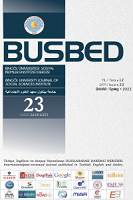ERGANİ İLÇESİNİN (DİYARBAKIR) JEOPARK POTANSİYELİ
GEOPARK POTENTIAL OF ERGANİ DISTRICT (DİYARBAKIR)
Author(s): Kemal KiranşanSubject(s): Archaeology, Museology & Heritage Studies, Regional Geography, Cultural Anthropology / Ethnology, Tourism, Geopolitics
Published by: Bingöl Üniversitesi Sosyal Bilimler Enstitüsü
Keywords: Ergani; Geopark; Geotourism; Geomorphology;
Summary/Abstract: Tourism has an important role in protecting, promoting and transferring natural and human (cultural) values to future generations. Geotourism is a tourism activity based on the sustainable use of values that have witnessed the past history of the place in any area. Geoparks are the most important way of maintaining geotourism activities in systematically. Geoparks are private nature protection areas where the same or different types of geo-heritage or geosites are found collectively open to visitors, managed and not less than walking distance. The district of Ergani is geographically located in the Upper Euphrates Section of the Eastern Anatolia Region of Turkey. Tectonically, it was established in the south of the Maden Mountains, which belong to the Southeast Taurus Mountain belt, on the border of the border fold belt and Diyarbakır basin. There are important geopark elements originating from the geological, geomorphological, archaeological and historical features of the site. Hilar caves and Çayönü, Hendek caves, nummulitic fossil field, folds and thrust structures, volcanic and karstic shapes, mounds, Assyrian reliefs and many historical values are some of these. No study in the literature evaluates and reveals the natural (geographical) and human (cultural) values in Ergani district in terms of geopark potential. The aim of this study is to determine and evaluate the geopark potential of natural (geographical) and human (cultural) values in Ergani district. For this, literature data, 1/100,000 scaled printed geology maps, 1/250,000 scaled printed active fault maps, 1/25,000 scaled printed topography maps, 10*10 m resolution Digital Elevation Model data, Google Earth images and field study data were used. In evaluating the data, Geographic Information Systems (GIS) technologies and geomorphological methods were evaluated together. As a result of this study, many geopark elements originating from geological, geomorphological, archaeological and historical features have been identified in Ergani district. Fossil sites, fold structures and thrust faults, various karstic shapes (lapia, cave), pyroclastic cones, mounds, ancient cave settlements, castles and churches can be given as examples.
Journal: Bingöl Üniversitesi Sosyal Bilimler Enstitüsü Dergisi (BUSBED)
- Issue Year: 12/2022
- Issue No: 23
- Page Range: 226-248
- Page Count: 23
- Language: Turkish

